How a Quality Approach to Europe Paid Off Over the Long Term


European markets are garnering attention again in 2017. Most of the flows have targeted broad beta benchmarks in simple execution of a regional allocation. For longer-term and strategic allocators who will hold positions in Europe for many years, WisdomTree believes focusing on a factor approach for European markets can add significant value and address some of the concerns investors might still have regarding the current set of stocks with high exposures in traditional market cap-weighted indexes.
Long-Term Returns to a Quality Approach
A growing line of academic research has focused on the “quality factor.” The Fama and French three-factor model, which started off looking at just beta, size and value as three principal drivers of returns, added quality as a key additional factor that can influence returns. But what do we and Fama and French mean by “quality”? If we look to their formal definition, profitability is described as “annual revenues minus cost of goods sold, interest expense and selling, general and administrative expenses, all divided by book. We call this variable operating profitability, OP, but it is operating profitability minus interest expense.”1
The simpler variable and term people will be familiar with: return on equity (ROE) or profits over equity.
That is the same variable Warren Buffett often focuses on when he describes companies he is most interested in acquiring that deliver high ROE with little debt.
When we look at the returns to the European markets over the last 30 years, in the large-cap space, the difference between large-cap high-quality stocks and large-cap low-quality stocks is substantial: on the order of almost 7 percentage points per year. This leads to a dramatic long-term chart for European high-quality firms compared to European low-quality firms.
Long-Term Returns to European Quality (ROE)
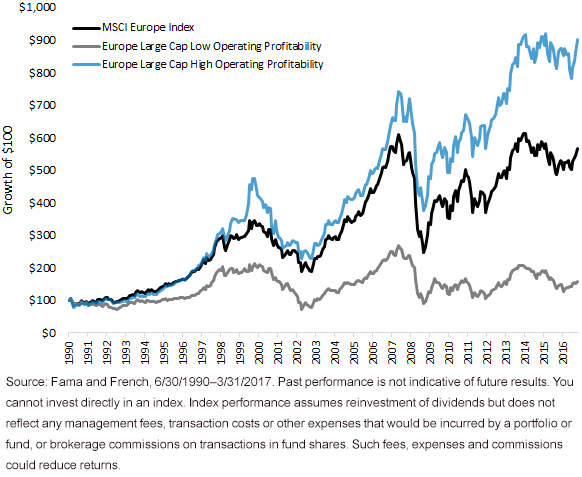
For definitions of indexes in the chart, visit our glossary.
5x5 Matrix of Size and Operating Profitability
Fama and French have a 25-portfolio matrix where they show the returns for operating profitability across size segments. One of the most noticeable observations is how the returns to the lowest operating profitability segment are a sharp drop-off from even just the low operating profitability segment above it. That means some of the greatest advantages are found by just avoiding the junkiest profitable companies.
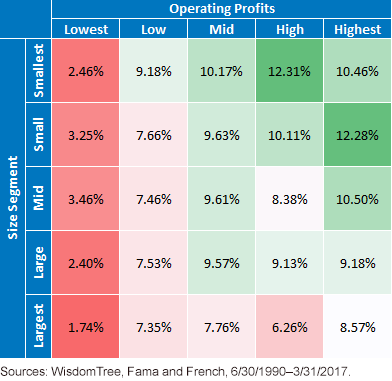
Where are these bottom-quintile ROE companies today? Predominantly among financials, energy companies, materials and industrials.
Bottom-Quintile ROE Sector Market Cap Breakdown
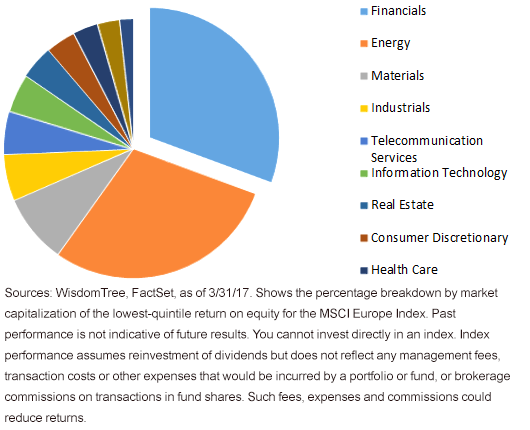
WisdomTree created its Europe Quality Dividend Growth Index in 2014, and it was designed to avoid the exposures in the bottom quintile of profitability shown above. When we look at different profitability buckets today for the MSCI Europe Index contrasted with WisdomTree’s approach, you can see how WisdomTree shifts the weight in exposures toward the top half of the market on a profitability metric like ROE.
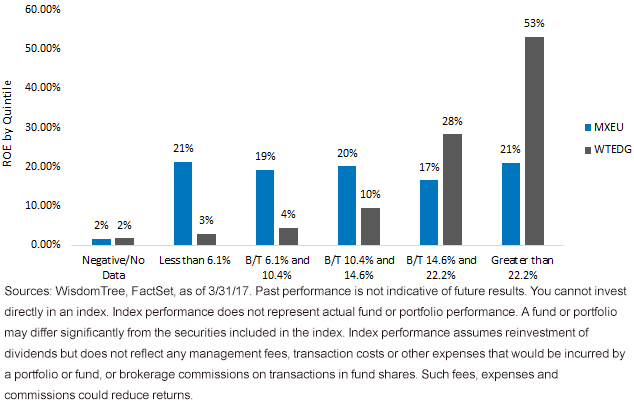
The returns of the WisdomTree Europe Quality Dividend Growth Index and the ETF that tracks it after fees and expenses, EUDG, have been competitive since the launch of the Index three years ago—compounding average annual returns for both at more than 200 basis points (bps) per year ahead of the traditional market cap index. The research by WisdomTree and academics such as Fama and French shows that operating profitability can be an important factor in driving long-term returns. As investors position for a rebound in the long-term performance of European markets, we’d advocate for considering a quality-driven approach.
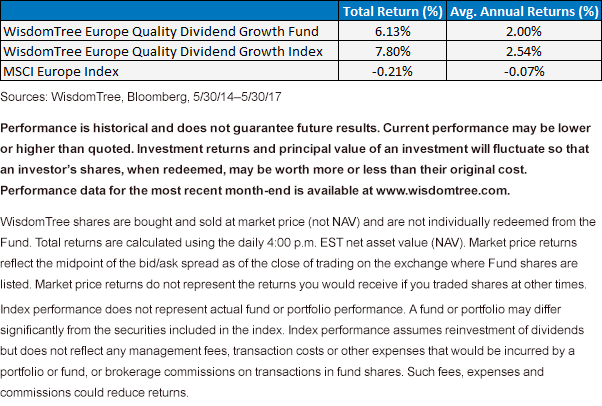
Please click here for standardized performance of EUDG
1See, for instance, the Fama and French paper “A Five-Factor Asset Pricing Model.”
Important Risks Related to this Article
There are risks associated with investing, including possible loss of principal. Foreign investing involves special risks, such as risk of loss from currency fluctuation or political or economic uncertainty. This Fund focuses its investments in Europe, thereby increasing the impact of events and developments associated with the region, which can adversely affect performance. Dividends are not guaranteed, and a company currently paying dividends may cease paying dividends at any time. Investments in currency involve additional special risks, such as credit risk and interest rate fluctuations. As this Fund can have a high concentration in some issuers, the Fund can be adversely impacted by changes affecting those issuers. The Fund invests in the securities included in, or representative of, its Index regardless of their investment merit, and the Fund does not attempt to outperform its Index or take defensive positions in declining markets. Please read the Fund’s prospectus for specific details regarding the Fund’s risk profile.
Jeremy Schwartz has served as our Global Chief Investment Officer since November 2021 and leads WisdomTree’s investment strategy team in the construction of WisdomTree’s equity Indexes, quantitative active strategies and multi-asset Model Portfolios. Jeremy joined WisdomTree in May 2005 as a Senior Analyst, adding Deputy Director of Research to his responsibilities in February 2007. He served as Director of Research from October 2008 to October 2018 and as Global Head of Research from November 2018 to November 2021. Before joining WisdomTree, he was a head research assistant for Professor Jeremy Siegel and, in 2022, became his co-author on the sixth edition of the book Stocks for the Long Run. Jeremy is also co-author of the Financial Analysts Journal paper “What Happened to the Original Stocks in the S&P 500?” He received his B.S. in economics from The Wharton School of the University of Pennsylvania and hosts the Wharton Business Radio program Behind the Markets on SiriusXM 132. Jeremy is a member of the CFA Society of Philadelphia.

